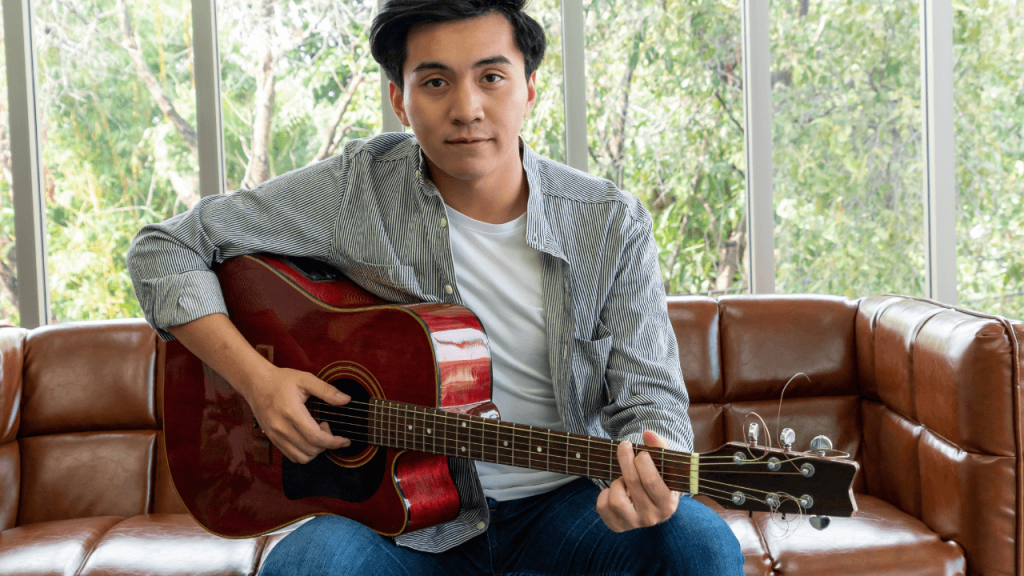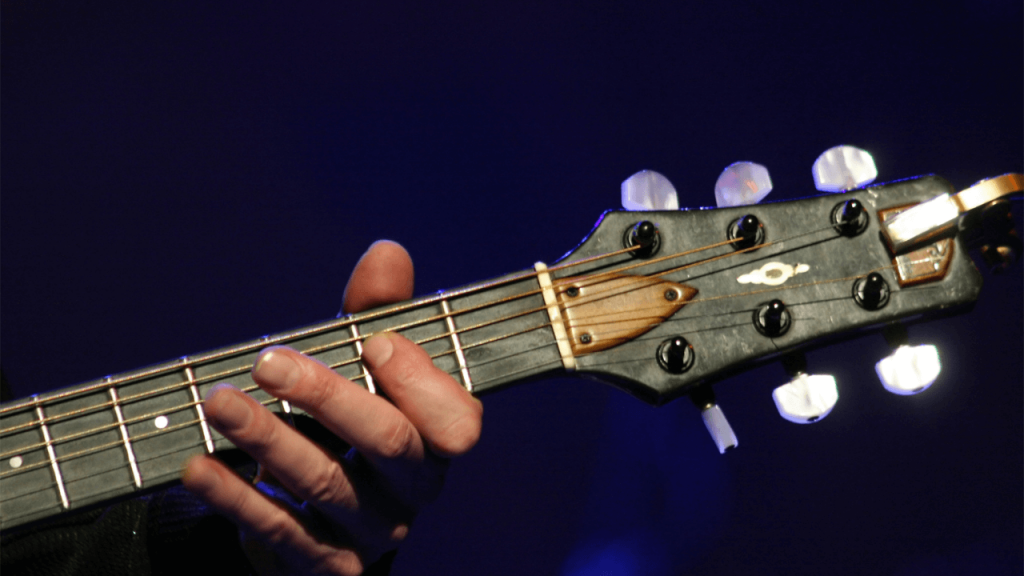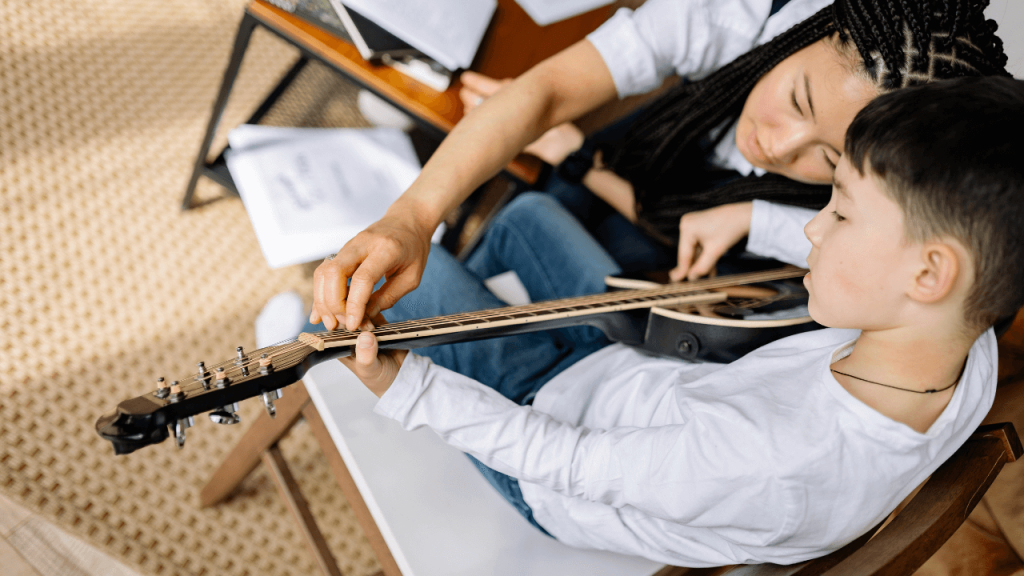Learning how to hold a guitar properly is the foundation of every guitarist’s journey. Whether you’re a beginner or an experienced player, the way you hold your instrument significantly impacts your playing technique, comfort, and overall performance.
In this comprehensive guide, we will explore the essential techniques for holding a guitar, covering both sitting and standing positions, proper neck positioning, posture, classical vs. casual positioning, and common mistakes to avoid.
By mastering these techniques, you’ll unlock your potential to create beautiful music while keeping your hands and body in optimal playing condition.
I. How to Hold a Guitar While Sitting
When it comes to sitting and playing the guitar, achieving a comfortable and balanced posture is crucial for maintaining long-term playing endurance and reducing strain on your body. Follow these steps to hold a guitar correctly while sitting:

Find a suitable chair: Choose a chair without armrests that allows you to sit up straight with your feet planted firmly on the ground. This will provide stability and proper support.
Position the guitar: Rest the lower curve of the guitar body on your dominant leg. For right-handed players, this will be your right leg, while left-handed players will rest it on their left leg.
Support the guitar body: Use your forearm to support the guitar body from below, ensuring that it remains stable and balanced. This will prevent the guitar from sliding down your leg while playing.
Relax your arms and shoulders: Allow your arms to hang naturally, keeping your shoulders relaxed and free from tension. Avoid raising your shoulders or tensing your muscles, as this can lead to fatigue and discomfort.
Hand and wrist position: Place your strumming hand comfortably on the guitar body, close to the bridge or soundhole. For the fretting hand, keep your wrist straight and avoid excessive bending or twisting.
Experiment with cushions or footrests: Depending on your height and the guitar’s size, you may find it helpful to use a footrest or cushion to adjust the guitar’s height and angle for optimal comfort and playing position.
II. How to Hold a Guitar While Standing
Playing the guitar while standing offers greater mobility and stage presence. However, it requires a slightly different approach to ensure stability and ease of playing. Follow these steps to hold a guitar correctly while standing:

Use a guitar strap: Attach a suitable guitar strap to the strap buttons on the guitar body. Adjust the length of the strap so that the guitar rests at a comfortable height, allowing your hands to reach the fretboard effortlessly.
Position the guitar: Place the guitar body against your torso, ensuring it rests comfortably. The lower curve of the guitar should align with your stomach area.
Maintain balance: Distribute the weight of the guitar evenly across your body by adjusting the strap length. This will prevent strain on your shoulder and neck muscles.
Find a comfortable playing position: Experiment with different strap lengths and guitar positions to find the most comfortable playing position for you. Some guitarists prefer to wear the guitar higher up on their chest, while others prefer a lower position. Find what feels natural and allows for easy access to the fretboard.
Use your non-dominant hand for support: Rest your non-dominant hand lightly on the guitar body or bridge to provide additional support and stability while playing.
Relax your arms and shoulders: Keep your arms relaxed and allow them to hang naturally. Avoid tensing your muscles or raising your shoulders, as this can lead to fatigue and discomfort during extended playing sessions.
Maintain good posture: Stand up straight with your back aligned and shoulders relaxed. Avoid slouching or leaning too far forward or backward, as this can affect your balance and playing technique.
Engage your core: Activate your core muscles to help support your body while standing and playing. This will contribute to your overall stability and control.
III. How to Hold a Guitar Neck
Proper positioning of the guitar neck is essential for achieving precise finger placement and smooth chord transitions. Follow these guidelines for holding the guitar neck correctly:

Support the neck with your left hand (for right-handed players): Place your thumb on the back of the guitar neck, opposite your fingers. Your thumb should lightly press against the back of the neck, providing stability and control.
Use the base of your index finger as a pivot point: Position the base of your index finger (around the first knuckle) on the guitar neck. This point will act as a pivot while your other fingers move along the fretboard.
Curve your fingers: Create a gentle curve with your fingers, allowing them to hover above the fretboard. This curve facilitates efficient finger movement and prevents unintentional muting of adjacent strings.
Light but firm grip: Avoid gripping the neck too tightly, as it can restrict finger movement and lead to hand fatigue. Instead, maintain a light but firm grip on the neck, providing control without unnecessary tension.
Finger positioning: Place your fingertips just behind the frets, ensuring clean and clear notes when pressing down on the strings. Avoid placing your fingers too far away from the frets, as it may cause buzzing or muted notes.
Minimize thumb movement: While playing, try to keep your thumb centered on the back of the neck, allowing it to support your hand and provide stability. Minimizing excessive thumb movement helps maintain a consistent hand position.
Relax your hand and wrist: Keep your hand and wrist relaxed while holding the guitar neck. Tension in these areas can hinder your playing and lead to discomfort or strain over time. Remember to take breaks and stretch your hands regularly during practice sessions.
IV. How to Have Good Guitar Playing Posture
Maintaining good posture while playing the guitar is vital for preventing discomfort, fatigue, and potential long-term injuries. Follow these posture tips for a healthier and more enjoyable playing experience:
Sit or stand tall: Keep your back straight and upright, avoiding slouching or rounding of the shoulders. Imagine a string pulling you upward from the top of your head, aligning your spine in a natural and relaxed position.
Relax your arms and shoulders: Allow your arms to hang naturally from your shoulders, keeping your shoulders relaxed and free from tension. Avoid raising your shoulders or tensing your muscles, as this can lead to fatigue and impede your playing ability.
Balance your weight: Distribute your body weight evenly across both feet if you’re standing, or on your sitting bones if you’re sitting. This helps maintain stability and prevents excessive strain on one side of your body.
Position your head and neck: Keep your head aligned with your spine, avoiding tilting it too far forward or backward. This allows for a neutral neck position, reducing strain on your neck and upper back.
Engage your core: Activate your core muscles by gently contracting your abdominal muscles. This provides stability and support for your spine, allowing for better overall posture.
Relax your hands and wrists: Keep your hands and wrists in a relaxed and natural position. Avoid excessive bending, twisting, or tension in these areas, as it can lead to discomfort and limit your dexterity.
Take breaks and stretch: During practice sessions, take regular breaks to stretch your muscles, particularly your neck, shoulders, arms, and hands. Simple stretching exercises can help alleviate tension and maintain flexibility.
V. Classical Positioning vs. Casual Positioning
Guitarists have the choice between two primary playing positions: classical and casual. Understanding the differences between these positions can help you choose the one that suits your playing style and preferences:
Classical Positioning
Classical positioning, also known as the classical guitar posture, is commonly used by classical guitarists and fingerstyle players.
It involves the following:
Resting the guitar on your non-dominant leg: For right-handed players, the guitar rests on the left leg, while left-handed players rest it on the right leg.
Using a footstool: A footstool is often employed to elevate the non-dominant leg, raising the guitar to a suitable height.
Guitar tilted upwards: The guitar is angled upward at around a 45-degree angle, allowing for better visibility of the fretboard and easy access to all strings.
Elevated neck position: The neck of the guitar is raised slightly, pointing upward. This positioning promotes proper left-hand technique and facilitates clear string separation.
Classical positioning provides stability, encourages proper hand positioning, and facilitates precise fingerpicking and classical guitar techniques. It is favored for its emphasis on control and precision.
Casual Positioning
Casual positioning, also referred to as the casual or folk guitar posture, is commonly used in various music genres, including rock, pop, blues, and folk.
It offers a more relaxed and versatile playing style:
Resting the guitar on your dominant leg: Right-handed players typically rest the guitar on the right leg, while left-handed players rest it on the left leg.
No footstool: Unlike the classical position, a footstool is not necessary in casual positioning. The guitar is positioned lower, typically resting on the thigh.
Guitar angle and neck position: The angle of the guitar and neck can vary depending on personal preference. Some players prefer a more horizontal position, while others may tilt it slightly upward.
Casual positioning allows for greater freedom of movement, facilitates strumming patterns, and is well-suited for chord-based playing. It is favored for its comfort and ease of play.
VI. Common Mistakes to Avoid
While learning how to hold a guitar, it’s crucial to be aware of common mistakes that can hinder your progress and potentially lead to discomfort or injuries. Avoid the following errors:

Hunching your back or shoulders: Slouching or hunching your back while playing the guitar can lead to poor posture and strain on your back and shoulders. Maintain an upright posture and avoid rounding your shoulders to prevent discomfort and potential injuries.
Gripping the neck too tightly: Holding the guitar neck with excessive force creates unnecessary tension in your hand and wrist. This can hinder your finger movement, slow down your playing, and cause fatigue. Instead, maintain a relaxed but firm grip on the neck.
Incorrect wrist position: Bending or twisting your wrist excessively can put strain on the tendons and lead to discomfort or even injuries like carpal tunnel syndrome. Keep your wrist in a neutral and relaxed position to allow for smooth finger movement across the fretboard.
Incorrect guitar angle: Holding the guitar at the wrong angle can affect your playing technique and strain your wrist. Avoid holding the guitar too horizontally or too vertically. Aim for a slight upward tilt that allows for easy access to the fretboard and a comfortable wrist position.
Neglecting proper thumb placement: Your thumb plays a crucial role in supporting your hand while playing. Avoid tucking your thumb over the top of the neck, as it can hinder your finger movement and create tension. Instead, position your thumb behind the neck, opposite your fingers, providing stability and control.
Poor strap adjustment: If you’re playing while standing and using a guitar strap, improper adjustment can affect your playing comfort and technique. Ensure the strap is adjusted to a length that allows the guitar to rest comfortably against your body, balancing its weight evenly.
Neglecting breaks and stretching: Playing the guitar for extended periods without breaks or stretching can lead to muscle fatigue and discomfort. Take regular breaks during practice sessions, stretch your fingers, hands, arms, and shoulders, and give your muscles time to rest and recover.
Conclusion
Learning how to properly hold a guitar lays the foundation for becoming a skilled and comfortable player. By mastering the techniques discussed in this guide, you’ll enhance your playing ability, prevent injuries, and unlock your true potential as a guitarist.
Remember, practice and consistency are key, so keep honing your skills while maintaining a mindful approach to your playing technique. Happy playing!

